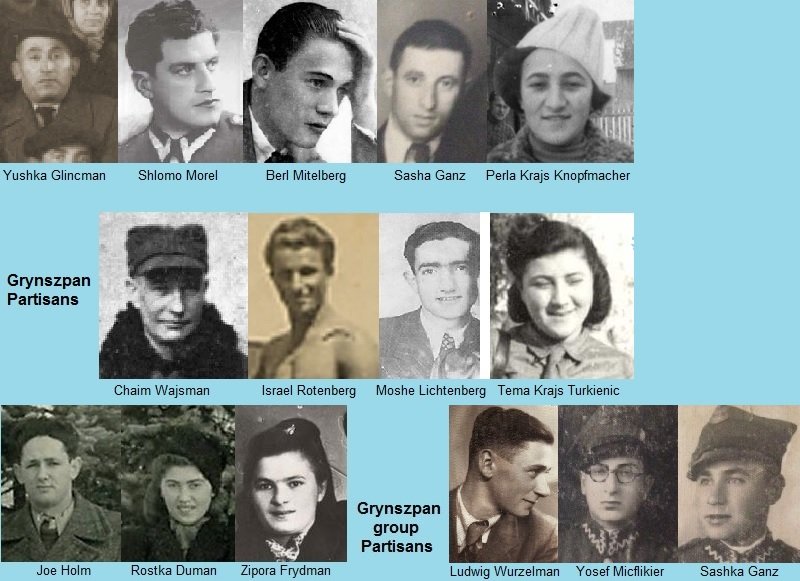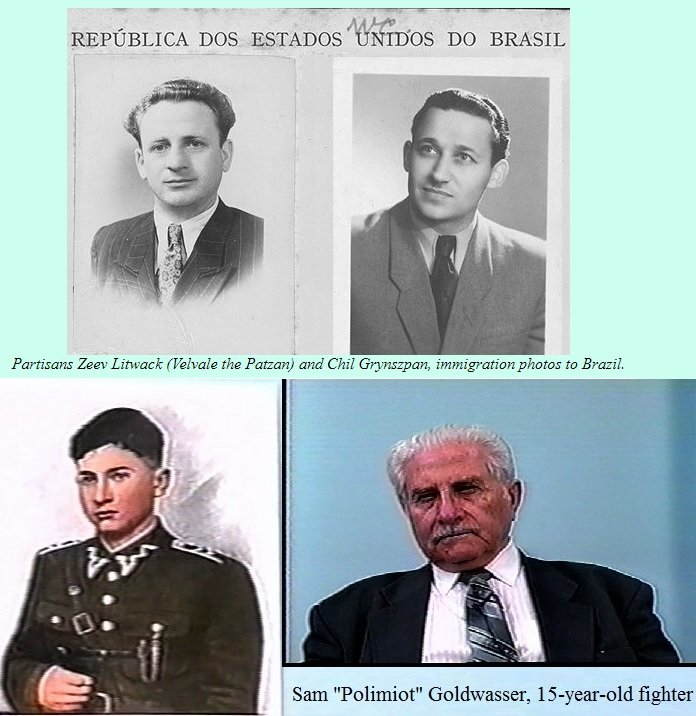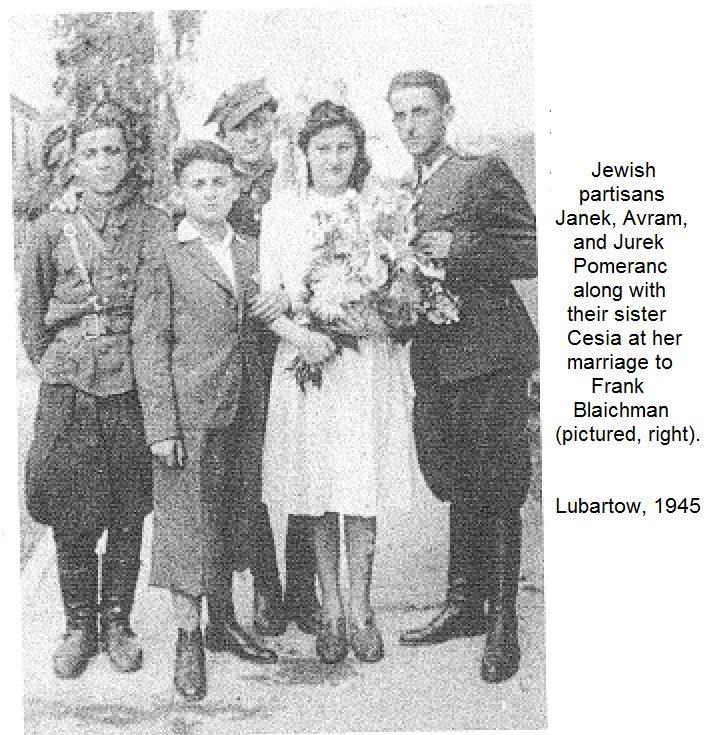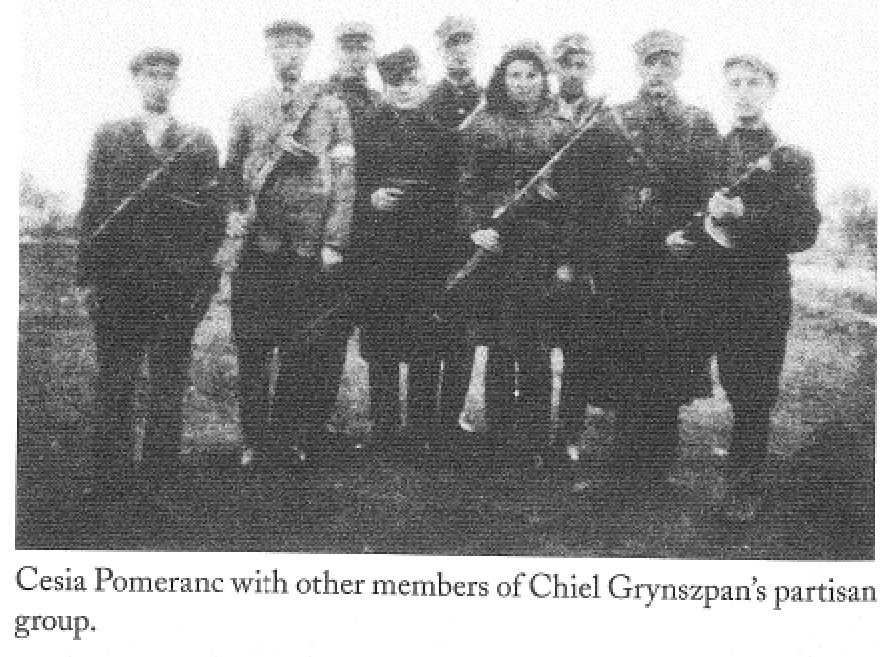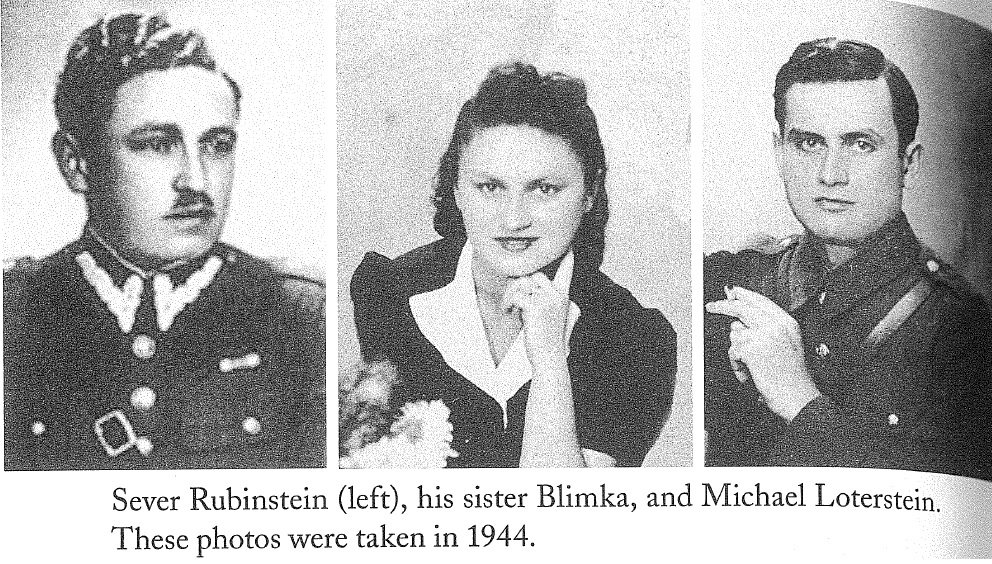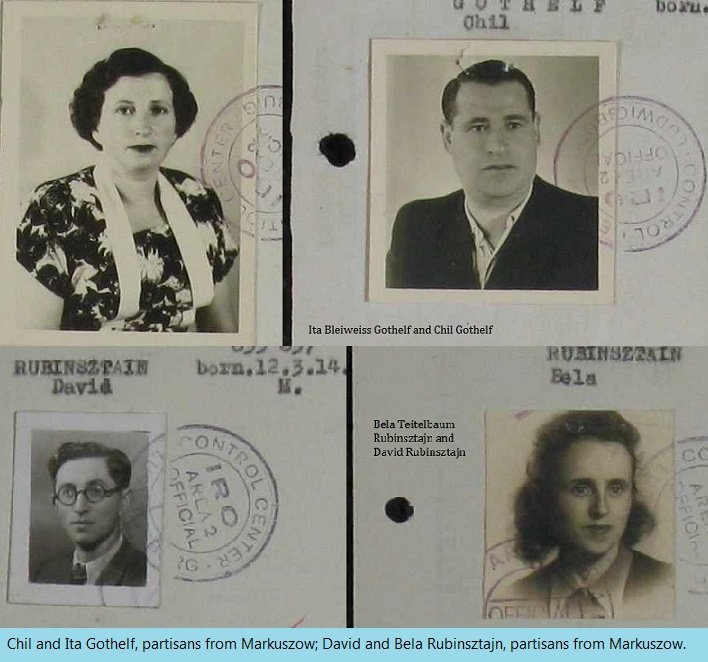Remember the Jewish Partisans of the Lublin District - Groups North of Lublin
Groups Northwest of Lublin: In Markuszow and Kamionka in 1942, groups of young Jews who escaped from ghettos or otherwise avoided capture managed to acquire weapons and food. When the Jewish community of Markuszow was rounded up, some 700 Jews fled. The four separate Jewish partisan groups -- one led by Mordechai Kirshenboim, a second led by brothers Yerucham and Yaakov Gotheilf, a third called the Cossacks, and a fourth group from Kamionka led by Frank Blaichman -- set up camps in the Wola forests. In early December of 1942, a group of S.S. men and Ukrainian auxiliaries arrived near Markuszow to search the forests for hidden Jews. On December 2, the first day of the search, about 400 Jews were killed. Another 600 perished before the sweep ended on January 20, 1943.
Thus, the first three groups of partisans mentioned above were exterminated. The only survivors of "the Cossacks" group, per Samuel Gruber's testimony, were Jusek Piasaki and Jerzy Marcinek. These two later merged with Gruber's group. There were two specific incidents still in memory today from the survivors. These incidents occurred after years on the run and in hiding. Near Markuszow was a village called Pryszczowa Gora, built on a peaty area with 350 families in the village. The residents, all peasants, were poor. Markuszow Jews built caves and camouflaged themselves at this locale. The shochet went out one day and was spotted by the military police after a local villager complained. The Germans were led to the entrance of the cavesite. The cave entrances were stuffed with straw and set on fire. All of the Jews were dead, except one little girl. She was taken in by the villagers and passed from house to house. The second incident concerned a separate group of Markuszow fighters, the Emilia Plater group led by Shmuel Yaeger. On Feb. 4, 1944, there were three unknown peasants at a barn owned by a farmer the partisans knew in Pryszczowa Gora. The threesome had reported the Jews to the Germans, and by the time the partisans realized this they were ambushed. The two survivors of this incident were Janek (also called Yosel), unknown surname, and Sziye Goldberg. They were both severely wounded.
Frank Blaichman's group was more successful because they were better armed. The group began with around 75 fighters, but in fall of 1942 50 of their fighters were killed in battle, leaving just 25 remaining. Blaichman's group was very successful in acquiring weapons, which several of the other Jewish partisan groups had great difficulty achieving. At just age 16 when the war started, Frank Blaichman became an unlikely leader and hero. He had no military background or training, but assumed the role of leader of the group for the purpose of avenging the blood of his murdered family members. The Blaichman group merged with a group led by Shmuel "Mietek" Gruber in the summer of 1943. The combined group total was around 90 fighters.
All Jewish members of the Polish Army were sent to the Lipowa 7 Labor Camp in Lublin. Samuel Gruber and other Lipowa 7 inmates were forced to build the Majdanek Concentration Camp as part of their slave labor detail. Gruber had been injured in a battle in the campaign against the Nazis, so he was eventually taken out of slave labor. He remained at the Lipowa camp, but was assigned to work in an office of a hospital that distributed uniforms, rifles, and pistols to German soldiers coming from the front. He was able to steal weapons, which he funneled to the anti-German Polish underground. In October of 1942, Gruber and another prisoner named Kaganowicz (first name either Berko or Josef) led a group of around 25 men into the Kozlow woods north of Lublin. After Gruber's group, several other groups of prisoners from Lipowa 7 also escaped into the woods. They were aided by a People's Guard Polish detachment.
Gruber's group had difficulty finding weapons after escaping from Lipowa 7. His group had around 20 persons and was largely unarmed, but had local connections with friendly farmers -- especially in a particular hamlet north of Lubartow called Wola Przybyslawska, where the villagers were involved in the Polish underground. The Gruber group placed vulnerable, sick, or elderly Jews with farmers they could trust to avoid attracting attention.
The Blaichman and Gruber groups merged in summer, 1943, and together they hunted down Nazis and any Poles who collaborated with them. They blew up the town halls in Garbow and Markuszow because the Nazis were going to use lists of Jews in those locales for slave labor. They picked off German patrols and stole German weapons. They initially fought in the area west of the Wieprz River in the Janowski (Yanov) forest west of Lublin. The combined forces acquired rifles, pistols, and machine guns as well as food and clothing obtained from various sources, including Nazis, Polish villagers, and an occasional political ally. This combined group, "The Lubartow Group", reached Chil Grynszpan's groups in January of 1944 and merged with them. The combined groups had around 400 fighters and worked closely with the Armia Ludowa.
Groups Northeast of Lublin: Yechiel (Chil) Grynszpan was part of a horse-trading family and thus became familiar with the wagon routes and swamps in the forests near where he grew up prior to the war. His family mostly traded with non-Jews, and therefore he also knew which Polish farmers could be trusted. In late 1942, Grynszpan's group formed. They had around 50 fighters but only two rifles and one pistol. In early 1943 they came across the remains of weapons hidden after the battles of September 1939. The group managed to acquire seven more rifles, ammunition, and a small number of grenades. Grynszpan worked to motivate the partisans, proclaiming boldly, "You are born once -- you only die once!" He became a larger-than-life figure.
Grynszpan's group set up a camp called Tabor where Jewish elderly, children, and those too weak to fight could still survive under the protection of the unit and surrounded by dense forests. An estimated 1,000 Jews were at the camp. Few of them actually ended up surviving the war. The camp residents were mostly from local villages such as Kodeniec, Pachole, Zahajki, and Krzywowierzby. The three village elders who oversaw the Tabor camp were Abram from Zaliscze (Abram Cholomski), Yankel from Holowno (Jankiel Kupfersztajn), and Nuchem from Krasnowka. Jews set up a makeshift synagogue in the forests. They carried out various services for the partisans, such tailoring, shoemaking, and cooking.
The partisans in the Grynszpan group had some variety. Among them was a group of escaped prisoners of war from Lipowa 7 camp, Fiodor Kovalev's brigade of Russian fighters (including some Jews), and later the Gruber-Blaichman-Yaeger Jewish partisans from the Pulawy area. Grynszpan himself eventually formed a tight bond with the Armia Ludowa, which recognized the group as most organized Jewish resistance in all of eastern Poland.
Some of the activities of the Grynszpan group included the liberation of Jews from forced labor at Jablonia and Adampol, preventing German transportation abilities, and attacking German brigades. Velvele Litwack, one of the young fighters, describes specific activities of the group below.
Tragically, in the fall of 1943, the Nazis invaded the campsite and 75 of the around 200 of the Jews living in it were murdered. In the fall of 1943, more than a dozen of the Sobibor uprising escapees found Grynszpan's group -- each sick, starved, and frozen. They included: Yehuda "Atleta" Lerner, Mordechai Goldfarb, a Russian Jew with a pistol (Boris Taborinski), Abraham Margules, Hella Fellenbaum, Ajzik Rotenberg, Itzhak Lichtman, Ada Fischer, Kitty Gokkes, and Ursula Stern. Prior to finding the Grynszpan group, Sobibor survivors Lerner, Taborinski, and Moshe Goldfarb were with a group of six other Sobibor survivors who were lured into a group of around 20 Polish fighters led by two brothers called Piatek. Without warning, these Polish fighters attacked the Jewish Sobibor survivors near Hola, and six were murdered, including one woman. Three lived to tell the story. They left this group and continued to search for allies, and fortunately met the Grynszpan partisans.
The Lubartow group of Gruber and Blaichman eventually joined Chil Grynszpan's battalion. The combined units were tough, experienced, and disciplined by the fall of 1943. There were 150 people in the combined unit, including 20 armed women who fought alongside the men. They were fierce opponents to the Nazis and their collaborators and killed any Nazis they encountered. The group derailed bridges, blew up at least four army troop trains, hijacked German supply trucks on highways, cut phone poles between Lublin and Wlodawa, and attacked police headquarters and government posts in Kaplonosy and Parczew. Grynszpan group partisan Zev Velvele Litwack recalls:
On December 16, 1942 Chil led us to the village Ostrowa, where we started a heavy fight with the Hitlerists and after some hours we succeeded in conquering the position. German officers fell in our hands and 12 Polish policemen were shot. We captured many arms, uniforms, and other things. We burned down their housings and the town hall. The mayor, who had cooperated with the Germans, was shot. This was the first act of revenge for the Jewish bloodshed." But there was a price to pay: shortly after the victory, the Germans surrounded the partisans. The partisans were bombed for three days with planes and tanks. According to Litwack, "When they were about 40 meters from our range of sight came the order: 'Fire!' And we opened fire from all sides, so that the Germans did not know from where it came and they were standing in an open cornfield on their way towards us. In this battle we lost three partisans, two Russians and one Jew, Simcha Lewinson from Sosnowica. Tens of Germans were killed. After fighting for about five hours the Germans retreated."
1942 was a year with great snowfalls, storms and frosts. Winter was at its peak. The situation for the partisans was not good; most were naked, barefoot, and hungry. They attacked villages taking weapons and cattle by force, but lost Jewish fighters in each attack. Continues Litwack: "On January 11, we were surrounded in the forest of Parzew by a big German unit. But our Russian commander (Fiodor Kovalev) tricked them and we pushed back their attack. On February 26, 1943 at 11am, a group of 10 people with the commander Zemsta (Alexander Skotnicki, a Jew from the Armia Ludowa) were surrounded by 400 Germans. My comrades were sleeping in the hut of the forest guard and only I, wearing a German uniform, kept guard. The Germans approached, shouting: 'Comrade (friend)!' I threw myself down on the ground and started shooting at them. The Germans answered with heavy fire from machine guns. I detained them until the group left the hut and I succeeded in withdrawing to the other side. Our fighters, among them Zipora Koren (a teenager of around 15) opened fire and succeeded in passing and leaving the German encirclement.
In March 1943, the first planes with arms from the Soviet Union arrived. At the same time we separated from Russian partisans and formed a Jewish division under the leadership of Chil. We bombed trains near the village of Sarki, not far from Sobibor; we burned down a glass-works factory in Dubeczno. In Wyryki, we burnt the guardhouse, in Kaplonosy we attacked the German army and killed 26 Germans, and in Sosnowica we attacked a garrison and killed 120 Germans. Additionally, our forces destroyed the Bridge near to Sawin, where the railways passed on which the trains with German soldiers to the front were transported. One night we invaded in Parczew, burned the town hall and shot the guard. A week did not pass without our having removed from the rails a train with soldiers.
At the same time we stopped sleeping in the forest but slept instead in the villages that we had gained control of and where we had sympathetic non-Jews. The government of all councils of the whole district of Wlodowa went over to our side. Then Chil Grynszpan organized the division under the command of the Armia Ludowa, left-wing Polish fighters. Chil was promoted high commander.
In April, 1943 we were heavily attacked in the forest of Kaplonosy. In this battle we lost 70 Jewish fighters. Women and children rescued from the ghetto Wlodowa were also killed. It became known to us that in Adampol there were Jews from Wlodowa and Sosnowica. Nisan Cyn agreed to join me, but he was the only one. In the evening we both went to a farmer in Kaplonosy whom we knew very well. We promised him a good pig if he would bring us to the camp. He led us there and remained half a kilometer away of the camp and we continued. Nisan stood at the gate and I in German-uniform entered the camp. I took two Jews with me and left.
The winter months were slowly creeping until the summer of 1943 arrived. We were informed that Jews were still living in the ghetto. I learned that from my whole family which was killed in Sobibor, only father survived. I sent a farmer from the village Krasnowka to bring my father to the forest. The farmer returned without my father but with a letter from him in which it was written: 'My son, I don't have anything to live for and it is not worthwhile for me to come to the forest. G-d shall help you and guard you from all dangers. Revenge all, for the innocent Jewish blood which was shed'. On May 2, 1943 at night, Wlodowa was encircled by S.S.-men and Ukrainians driving out Jews from their hiding places. Tens of men, women, and children were shot in the street. My father too was shot on Wyryki street. This was the last action to dispose of Jews in the Wlodowa ghetto, which was one of the last remaining ghettos in the entire region.
One night I invaded in the first barrack of the camp Adampol. The Jews were already sleeping and I woke them taking along with me more than 30 people, ordering them to pass the fence while I jumped after them. All this was accomplished so silently that nobody noticed what happened. The farmer led us to the forest of Kaplonosy, where Chil Grynszpan was waiting with his whole group. This successful experiment increased our courage and we started enlarging our visits taking out Jews from Wlodowa, Sosnowica, Kaplonosy, Wyryki, and other places. Another day we made an assembly and decided to take all the Jews from Adampol, as we had learned that the last action was going to take place. It was determined that five men with arms should enter the camp hiding the arms and organizing the Jews to be prepared to leave the camp for the forest. Yurek Cholomsky and four others were sent.
But the Nazi head of the camp, Selinger, learned about the presence of the partisans in the camp and about their intention to lead the Jews out of the camp. He phoned the Gestapo in Wlodowa and on the same day some hundreds of them enclosed the camp and drove out all the Jews to the fields and fired at them. The five partisans went the first and when they were in the fields they shouted loudly all the Jews started escaping and dispersing in all directions. The Germans opened fire killing all the Jews**, except Yurek, a man from Wlodawa, and Yeshayahu from Wyryki. On this day, 600 Jews were massacred from Wlodowa and the surroundings. All were buried in a common grave next to Adampol.
In June 1943 we fought against the Germans behind the village Zahajki. Our commander was then Yechiel Grynspan, who conducted the battle with exceptional fighting spirit and strategic talent. In the same battle we lost two fighters. One was Yeshayahu Lichtenstein, the son of the Rabbi of Wlodowa. In every place we went, we were ambushed by Germans and Poles filled with hate for the Jews. We fought against them day after day. We were never able to relax because of the terrible situation we had to confront. For us, there was not much hope that we would survive this devastation. But within each of us existed a great spirit to rise up to fight.
** It is known that not all of the Jews from Adampol camp were killed. In fact, many had escaped prior to being killed.
One daring, but ultimately unsuccessful, action devised by the Grynszpan unit was an attempt to liberate 770 Jewish prisoners from the Krasnik Labor Camp (Skret). Liaison was established with the Jews inside the camp, who were supplied with 30 revolvers and a number of hand grenades. A plan for concerted action was carefully developed -- the revolt inside the camp was to flare up simultaneously with the partisan attack from the outside. An informer revealed the plans to the Nazis. Several days before the scheduled revolt was to take place, the Nazis seized the armed rebels inside the camp, killed the bulk of them, and transferred others to nearby Budzyn Labor Camp.
By July of 1944, Chil's partisan forces -- which had formed an alliance with the Armia Ludowa -- was surrounded by German soldiers. On July 22, the Red Eighth Army passed them during the night, and the partisans from the Mietek and Grynszpan groups were behind the front line of liberated Poland. Of the roughly 4,000 Jews who had fled to the forests of Parczew,
Markuszow, and Wlodawa between 1940 and 1944, only around 200 were still alive. Chil's group was one
of the most successful partisan detachments in all of Europe.
Wlodawa is located east of the Bug River, near Sobibor. In this area, scores of sub-camps of Sobibor were
set up and captured Jews were engaged in heavy forced labor. In October of 1942, a separate group of
around a dozen partisans formed outside of Adampol, Poland. Freedom was a new concept for this group,
as most had been imprisoned in the Wlodawa or Adampol ghettos and had found a way to escape. This
group was the beginnings of the Moshe Lichtenberg group.
By March, 1943 the group had around 30 fighters including around 27 males and three females. The Polish farmer Papinski was a messenger between the Lichtenberg group and local populations. In May, 1943 the Wlodawa Ghetto was liquidated. Between the partisan groups in the area, there were at least four rescue missions into the Wlodawa Ghetto to smuggle Jews out of it, and over 100 Jews were taken out of the ghetto or the nearby Adampol Labor Camp. The Lichtenberg partisan group gained new members until it reached 80 fighters. The very young, very old or those without any weapons were relocated to a place called Ochozhe, an island inside the forest surrounded by very deep swamps. This was a family camp similar to the Tabor camp of the Grynszpan group, protected by the partisan fighters.
Lichtenberg's group, which eventually came to number 100 to 120 fighters (including 10 female fighters), briefly joined the Chil Grynszpan group, but Lichtenberg's leadership style clashed with that of Grynszpan. In July, 1943, a man named Kolka Meluch arrived in Wlodawa with a small brigade of fighters and explained that he was from the Bielorussian partisan movement headquarters. Lichtenberg believed him and followed him toward the headquarters with all 100+ fighters from the group. They crossed the Bug River to continue their struggle for freedom in the Soviet partisan movement. While there, unit leaders Moshe Lichtenberg, Motel Rosenberg and Chaim Fiszman were shot by Kolka in a dispute over machine guns. It was a devastating defeat for the partisans. Melech was not a partisan commander as he had stated, but simply a bandit in the forests looking for people to take advantage of.
After losing these key men, Leon Nemzer, who had served in the Polish Army, took over as the group's leader. The ammunition and food supplies of the Lichtenberg group were consistently very sparse. The local Poles in the area around Wlodawa were very hostile to the Jewish partisans. A few months after Nemzer became leader, the group of Jewish partisans was absorbed into the Molotov Partisan Brigade, which had four Otriads. Each of the Otriads had around 400 fighters. In April of 1944, the Soviet Army liberated the area where the partisans were.
Another group of Jews mostly from the Wlodawa area formed inside of the labor camp and eventually escaped. This group, led by Nachum Knopfmacher (Michael Kaftori in Israel), eventually merged with Lichtenberg's group, but the two leaders had different ideas about the right actions to take in the short term. Lichtenberg was more focused on revenge, while Knopfmacher’s group focused on freeing Jews from the Adampol Labor Camp.
NAMES OF PARTISAN FIGHTERS (incomplete) in the area north of Lublin:
Legend:
* = survived Sobibor Death Camp by escaping; then fought as a partisan
*** = escaped from Lipowa 7 labor camp; then fought as a partisan
@ = fought in Chil Grynszpan’s group as well as the Wlodawa partisan group
(( )) = escaped from Adampol labor camp; then fought as a partisan
||| = escaped from the Warsaw ghetto; then fought as a partisan







